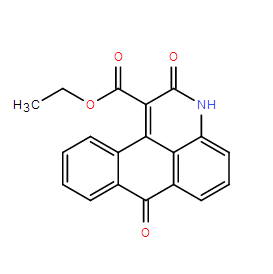| Description: |
NQDI-1 inhibits apoptosis signal-regulating kinase 1 (ASK1) with a Ki of 500 nM and an IC50 of 3 μM. |
| Target: |
ASK1:3 μM (IC50) |
| In Vivo: |
250 nmol NQDI-1 in DMSO is intracerebroventricularly injected following brain insult. Western blotting is performed to determine the expression of ASK1 in the sham, Hypoxia-ischemia (HI), DMSO and NQDI-1 groups and indicate that NQDI-1 markedly inhibits the expression of ASK1 in the brain cortex, compared with the HI and DMSO group. Furthermore, immunofluorescence staining also indicates that the expression of ASK1 is inhibited by NQDI-1 in the brain cortex. The expression of downstream targets of ASK1 is also determined in the present study. The expression levels of p-JNK, p-c-Jun, p53 and caspase 3 are significantly decreased by NQDI-1, compared with the HI and DMSO groups. Low expression of p-JNK in the brain cortex is also observed by immunofluorescence in the NQDI-1-treated group[2]. |
| In Vitro: |
The selectivity of NQDI-1 is evaluated in vitro on four serine/threonine protein kinases (protein kinase CK2 (CK2), c-Jun N-terminal kinase 3 (JNK3), Rho-associated protein kinase 1 (Rock1), and Aurora A) and three tyrosine protein kinases (FGFR1, hHGFR, and endothelial TEK tyrosine kinase (Tie2)). The results show that NQDI-1 is a selective inhibitor of ASK1. The activity of FGFR1 protein kinase is inhibited by NQDI-1 (residual activity of 44%). NQDI-1 inhibits ASK1 with a Ki of 500 nM. Inhibition of ASK1 by NQDI-1 is competitive with respect to the phosphodonor substrate ATP[1]. |
| Kinase Assay: |
Enzyme activity of human protein kinases ASK1, Aurora A, ROCK1, HGFR, FGFR1, Tie2, JNK3, and CK2 is determined using in vitro kinase assay (γ-32P-ATP method). Each reaction mixture contains 6 μL of buffer solution (25 mM MOPS, pH 7.2, 2.5 mM EGTA, 2.5 mM EDTA, 0.5 mM DTT, 0.25 mg/mL BSA, 20 mM β-glycerophosphate), 3 μL of substrate solution (MBP, Long S6 kinase substrate peptide, KKKSPGEYVNIEFG, IGF-IRtide (12-527), TK substrate 2, JNK3tide, or RRRDDDSDDD for each kinase, respectively) (5.0 μg/μL), 0.3 μL of enzyme (protein kinase catalytic subunit, 0.1 μg/μL≈32 mU/μL), and 10.25 μL of H2O. The reaction mixture (total volume of 19 μL) is quickly added to 1.5 mL tubes at room temperature. The stock solutions of inhibitors (e.g., NQDI-1) are prepared in DMSO, and the concentration of inhibitor is 1 mM. The concentration of DMSO in the reaction does not exceed 3%. Then 1 μL of inhibitor solution in DMSO is added to each tube and mixed by pipetting. ATP solution is prepared separately. For each sample 0.05 mCi γ-[P32]ATP is taken (specific activity of 100 μCi/μM). The total concentration of labeled and unlabeled ATP is 100 μM. The reaction is started with addition of ATP solution (150 μM ATP, 30 mM MgCl2, 15 mM MOPS, pH 7.2). The time of reaction is 20 min at 30°C. The reaction is stopped by adding 20 μL of 0.5 M orthophosphoric acid. Then the reaction mixture is loaded on the 20 mm filter disks of the cellulose phosphate paper. Filters are washed three times with 0.075 M orthophosphoric acid at room temperature and dried. For detection of products, dried filters are counted by Tri-Carb 2800-TR liquid scintillation analyzer. Then 1 μL of DMSO is added to the reaction volume instead of the inhibitor stock solution for a positive control[1]. |
| Animal Administration: |
Rats[2] A total of 12 female Sprague-Dawley rats with litters of mixed gender pups are used. The mothers are housed at 25°C under a 12-h light/dark cycle, with ad libitum access to food and water, until the pups are 7-days-old. The HI model is established. The pups are anesthetized with 2.5% halothane and are intracerebroventricularly infused with DMSO or 250 nmol NQDI-1, dissolved in DMSO into the right cerebral hemisphere 30 min prior to HI using a 30-gauge needle with a 5 μL Hamilton syringe (infusion rate, 1 μL/min). |
| References: |
[1]. Volynets GP, et al. Identification of 3H-naphtho[1,2,3-de]quinoline-2,7-diones as inhibitors of apoptosis signal-regulating kinase 1 (ASK1). J Med Chem. 2011 Apr 28;54(8):2680-6.
[2]. Hao H, et al. NQDI-1, an inhibitor of ASK1 attenuates acute perinatal hypoxic-ischemic cerebral injury by modulating cell death. Mol Med Rep. 2016 Jun;13(6):4585-92. |

 DC Chemicals' products qualify for U.S. tariff exemptions. We guarantee no price increases due to customs duties and maintain stable supply, continuing to deliver reliable research solutions to our American clients.
DC Chemicals' products qualify for U.S. tariff exemptions. We guarantee no price increases due to customs duties and maintain stable supply, continuing to deliver reliable research solutions to our American clients.





















